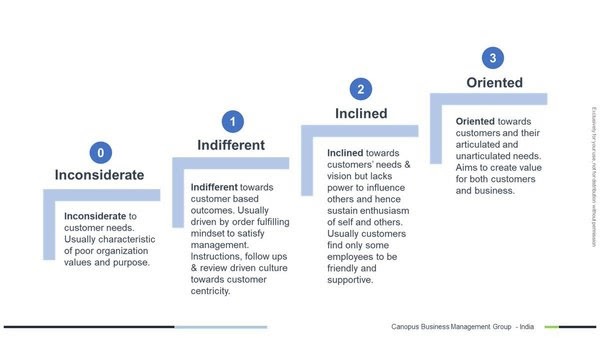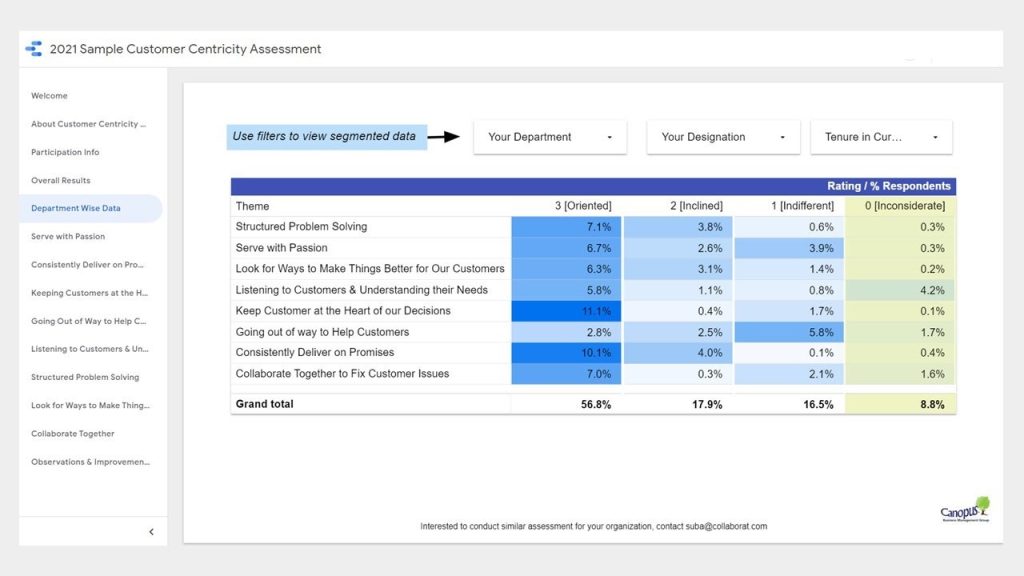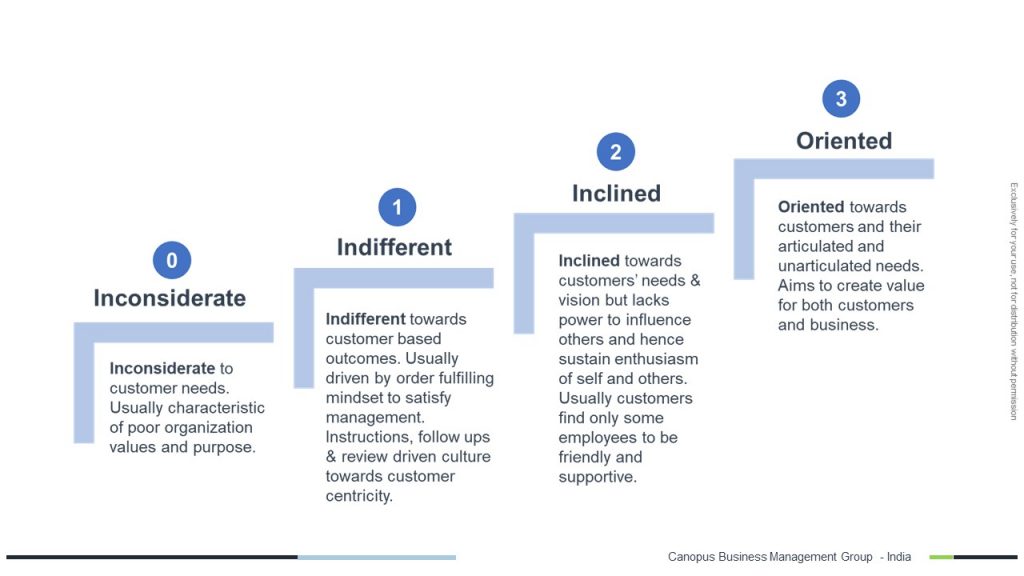
Behavioral and cultural maturity on Customer Centricity with maturity grid..
An unique attitude based organizational evaluation is used to understand behavioral and cultural maturity and can provide insights on where and what kind of attention is needed from leadership to improve Customer Centricity. Instead of dispersed efforts, they can take focused actions.
An overall maturity rating for the organization or cohort of employees will quantitatively assess current state.
A maturity grid below can give relative position and also provide a benchmark.
Customer Centricity Maturity Levels

To arrive at this maturity level:
- Customer Centricity of an organization across 8 dimensions is assessed and outcome will be an overall Customer Centricity Score against 4 maturity levels.
- Unlike traditional assessments, in this survey participants’ attitude is evaluated by giving them 8 random scenarios and they have to select what they will do or feel in each of the situation. This way, it eliminates respondent bias.
- Outcome is compiled in an interactive Customer Centricity report – a dashboard
Access Customer Centricity Maturity Interactive Dashboard here

For organizations of employee headcount (20 – 80) this Customer Centricity Evaluation is free.
#nilakantasrinivasan-j #canopus-business-management-group #B2B-client-centric-growth #Customer-Centricity-Evaluation
Canopus Customer Centricity in an organizational assessment to understand behavioral and cultural maturity of organization.
- It is a measure of Customer Centricity of organization across 8 dimensions using 4 maturity levels.
- Unlike traditional assessments, in this survey participants are given with 8 random scenarios and they have to select what they will do or feel in each of the situation. This way, it eliminates respondent bias.
Canopus Customer Centricity Maturity Levels are below:

- Use Chrome Browser for viewing
- Start from Welcome Page of report
- Use full screen
- Navigate across pages
- Use drop down to slice & dice the data to your convenience

While organizations like Disney and Ritz-Carlton have the luxury to hire front line staff based on Emotional Quotient (EQ), you will agree that not all of us have that levy. More importantly, in some sectors we have to weigh other skills such as technical, financial, engineering, software than EQ during hiring. For example, in product service, B2B front line, IT solutioning, etc., it is not a pragmatic aspiration to expect employees to possess high EQ & technical know-how.
Over the years, employees have understood the importance of customer centricity. So everyone wants to be customer centric but the question really is, how? Are the specific pointers that CXOs & HODs can give to their team on what to do? Motivating & inspiring them to do so is just as good as cranking the engine. What about throttling and shifting gears?
Unfortunately, there are very few leaders who go that far. If you want your employees to emulate certain behavior everytime-everyday, you have to be very specific and take a prescriptive approach.
Here are the 8 super simple behaviors that you can demonstrate every day, in meetings, field visits, reviews, planning, brainstorming sessions, or even when you scroll down a spreadsheet. Every customer facing employee (rather every employee) can be encouraged to imbibe these practices to become customer centric that will facilitate value generation for customers & business.
We will start with the simplest and go down to the difficult ones.
- Consistently deliver on promises: This is the simplest way to build trust and usually doesn’t cost much. And promises, whether big or small, are what we voluntarily make! So, it’s pretty much in our control.
- Permanent Issue Resolution: Whatever technology and processes we put in place, problems do crop up, every now and then. These issues are irritants for customers. Imagine, how many different products and services he/she uses. If we learn to go to the root of the customer issue and fix it permanently, we are not only helping this customer, but proactively preventing many such issues. This is when we can devote our energies towards constructive strategies.
- Collaborate together to fix customer issues: Organizations have become complex systems and authority is largely decentralized. Unless we collaborate internally and externally with all stakeholders, we will never put up a good show in front of customers.
- Listening to customers and understanding their needs: While it sounds very simple, it’s important to recognize every customer is unique. Furthermore, needs and requirements are very different. And lest, we have time to listen.
- Look for ways to make things better for our customers: Unearthing the unarticulated needs of customers pushes it by one more notch. Real and productive innovation starts here.
- Going out of way to help customers: We are trained to follow rules, processes and policies. Many a time, the biggest hindrance to customer centricity are none but these factors. The courage to challenge and break them when the situation really warrants is not short of heroism in Customer Centricity.
- Keep customers at the heart of our decisions: We are in business and not in charity, but when it comes to day to day decisions, do we weigh customers equally as business?
- Serve with Passion: While the first 6 points hinged on skill & action, the last two are about will. Conviction is born at the bottom of the heart.
If you wish to learn more about these 8 behaviors or how to create buzz around customer centricity in your organization, happy to be of help any time.
#nilakantasrinivasan-j #canopus-business-management-group #B2B-client-centric-growth #Customer-Centricity
Sign-up for collaborat newsletter








